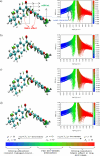Quantum Chemical Calculations, Topological Properties, ADME/Molecular Docking Studies, and Hirshfeld Surface Analysis on Some Organic UV-Filters
- PMID: 40290949
- PMCID: PMC12019759
- DOI: 10.1021/acsomega.4c10102
Quantum Chemical Calculations, Topological Properties, ADME/Molecular Docking Studies, and Hirshfeld Surface Analysis on Some Organic UV-Filters
Abstract
This study aimed to find a theoretical solution to the problem of photochemical instability of organic UV filters by changing the solvent environments. For this purpose, the four most important organic filters containing UV-sensitive groups, such as oxybenzone, avobenzone, octinoxate, and padimate O, were first selected, and the theoretically optimized geometries were determined by the density functional theory (DFT) method using the B3LYP/6-31G(d,p) basis set. Frontier molecular orbitals (FMOs) and molecular electrostatic potential (MEP) analyses were conducted to reveal differences in the reactivities of the molecules. The oscillator strengths, absorption wavelengths, and excitation energies in gas, water, ethanol, and n-hexane phases were determined with the help of the conductor-like polarizable continuum model (CPCM) and time-dependent density functional theory (TD-DFT) to study the effect of solvents on chemical parameters. In light of the obtained data, Natural localized molecular orbital (NLMO), atoms in molecules (AIM), and natural bond orbital (NBO) analyses were done to determine the stability and UV filtering capacity of the molecules. Additionally, topological and Fukui investigations were included. Molecular docking, ADME (absorption, delivery, metabolism, and excretion) properties, and Hirshfeld surface analysis were conducted. Finally, with the help of the theoretical data obtained, the results in different solvent environments are interpreted and compared with each other.
© 2025 The Authors. Published by American Chemical Society.
Conflict of interest statement
The authors declare no competing financial interest.
Figures













References
-
- Serpone N.; Dondi D.; Albini A. Inorganic and organic UV filters: Their role and efficacy in sunscreens and suncare products. Inorganica chimica acta 2007, 360 (3), 794–802. 10.1016/j.ica.2005.12.057. - DOI
-
- Bajpai P.Biermann’s Handbook of Pulp and Paper: Vol. 1: Raw Material and Pulp Making; Elsevier, 2018.
-
- Byrd-Miles K.; Toombs E. L.; Peck G. L. Skin cancer in individuals of African, Asian, Latin-American, and American-Indian descent: differences in incidence, clinical presentation, and survival compared to Caucasians. J. Drugs Dermatol. 2007, 6 (1), 10–16. - PubMed
-
- Lucas R.; McMichael T.; Smith W.; Armstrong B. K.. Solar ultraviolet radiation: global burden of disease from solar ultraviolet radiation; Prüss-Üstün A.; Zeeb H.; Mathers C.; Repacholi M., Eds.; World Health Organization, 2006.
LinkOut - more resources
Full Text Sources
